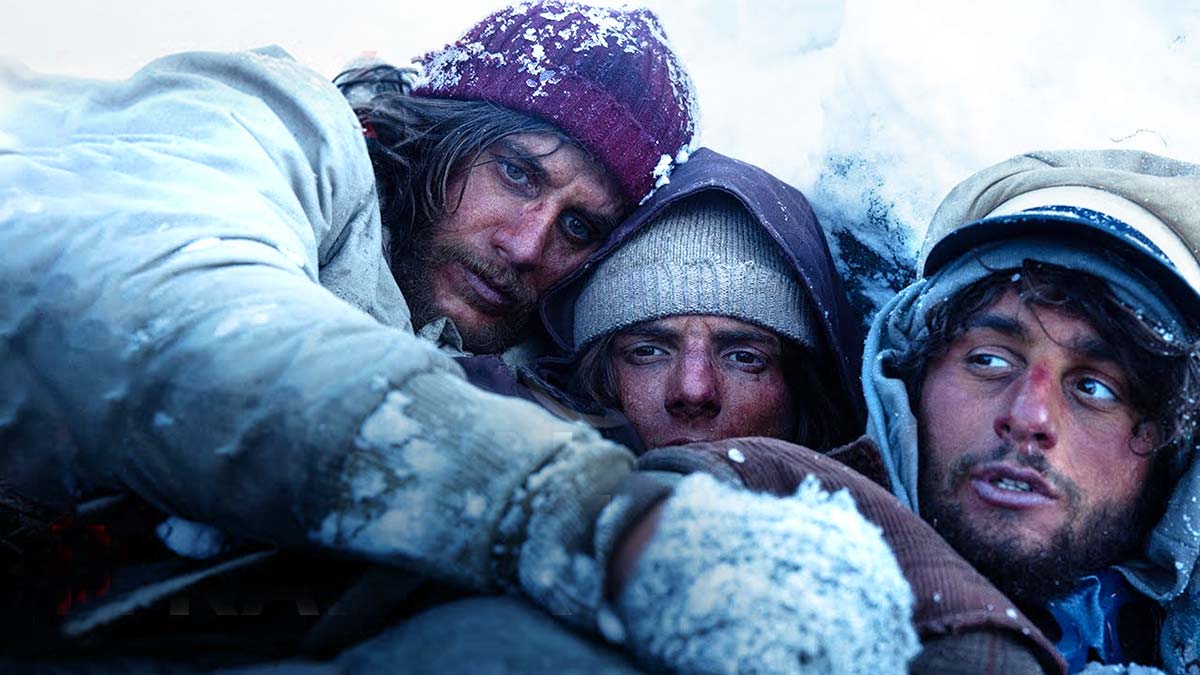
What ‘Alive’ Gets Wrong That ‘Society of the Snow’ Gets Right
Jan 20, 2024
The Big Picture
Society of the Snow tells a more authentic and dignified story of the Andes plane crash survivors compared to the Hollywoodized version in Alive. The movie portrays the trauma and suffering of the survivors in a tangible way, making their experiences feel more genuine and relatable. Society of the Snow is committed to telling an authentic story and pays homage to both the survivors and the deceased members of the crash. The film was shot on location and in chronological order for added realism.
While reviewing Alive, a movie based on the Andes plane crash survivors, the great Roger Ebert said that some stories can never be told and that perhaps the story of the Andes survivors is one of them. Still, it hasn’t stopped countless books, documentaries, and movies from attempting the same. Most recently, it’s Society of the Snow that has taken up the Herculean task. And for what it’s worth, the movie has corrected many errors made by its predecessor. Most recognizably, Society of the Snow casts Argentine and Uruguayan actors to better represent the faces of the tragedy, as opposed to Alive, where white North American actors such as Ethan Hawke and Josh Hamilton were almost comically named Nando and Roberto. But even on a deeper level, Society of the Snow tells a much more authentic and dignified story than any other movie on the same event. Here’s what Society of the Snow gets right that Alive doesn’t.
Society of the Snow In 1972, the Uruguayan Air Force Flight 571, chartered to fly a rugby team to Chile, catastrophically crashes on a glacier in the heart of the Andes. Only 29 of the 45 passengers survived the crash and finding themselves in one of the world’s toughest environments, they are forced to resort to extreme measures to stay alive. Release Date January 4, 2024 Cast Enzo Vogrincic , Esteban Bigliardi , Simon Hempe , Matías Recalt Runtime 144 minutes
‘Alive’ Hollywoodizes The Events Of The Andes
The story of the Andes plane crash received the Hollywood treatment in 1992 through Frank Marshall’s Alive. The movie tells the story of a Uruguayan rugby team who crashed into the Andes mountains and survived for 72 days before two people, Nando and Roberto, made a journey to Chile and found rescue. On paper, the movie followed closely with the events that transpired in Piers Paul Read’s harrowing book Alive: The Story of the Andes Survivors, but in execution, it lacks the heart to tell the story with an emotional punch. The problem with Alive is that it approaches the tragedy through the Hollywoodized lens of the adventure genre. Its focus is to tell a triumphant story where the survivors emerge as heroes. But in doing so, it severely undercuts the emotional and psychological impact of the ordeal that the survivors go through.
The horrors that the actual survivors went through continue to live within them after more than 50 years, but in Alive there’s a sense that the survivors get over the series of disasters they go through relatively easily. The group’s debate and, later, unanimous decision to consume the bodies of the dead passengers gets too brief a scene, and the aftermath of such a psyche-altering decision is lazily left to the audience’s imagination. Be it the plane crash, the avalanche, or the cannibalism, they’re all treated like formulaic plot beats, something to overcome and never mention again. Most annoyingly, though, the movie finds it necessary to add corny jokes here and there to add an unwarranted levity to the story.
This bright tone of the movie is only exacerbated by questionable performances from the cast, whose calm and chirpy demeanor stands jarringly in contrast with the grim scenario they’re in. There are even times when Alive comes off a little mean-spirited, especially in its depiction of the airplane mechanic, Fraga (José Zúñiga), who is made to seem maniacal, and Antonio Vizintin (John Haymes Newton), who comes off as insecure about his position as the captain of the team. The movie’s conclusion itself feels too abrupt in the very 90s fashion where films end as soon as the plot is resolved. The end result of it all is a movie that feels too pristine for the visceral source material that demands a raw treatment. This creates a very plasticky disconnect between the audience and the movie – you’re never really made to feel the character’s dilemma and suffering – making Alive a movie that can only be admired from afar and only for the already existing story it retells.
‘Society of the Snow’ Fixes Major Issues Of ‘Alive’
Society of the Snow essentially tells the same story of the Andes survivors, but its approach is more serious and dignified. As opposed to the earlier movie, Society of the Snow never attempts any unreal exuberance, and the portrayal always remains respectful. Its tone is a bleak one and what little optimism it has feels measured. Here, the characters feel more genuine as they seem to carry the mental and emotional scars of every disaster that befalls them, becoming more miserable but also more empathetic in the process. Unlike Alive, the trauma of the plane crash, the devastation of the avalanche, and the guilt associated with eating another human is an ever-lingering presence that shapes the way characters think and behave. The camera constantly calls attention to the survivors’ scars, bruises, and visible hunger, and it does the impossible of making their suffering feel tangible. At every step, the viewer feels compelled to wonder “Would I survive in this situation?”
Related ‘Society of the Snow’ Review: A Gripping Take on a Devastating True Story Technically immersive if a little narratively shaky at times, the year in cinema is still not complete until you see this film.
Society of the Snow doesn’t go down the predictable path of creating a tussle for leadership among its survivors. From the onset, the movie makes it clear that the only antagonist is the snowy landscape – the mountains are as magnificent as they are deathly – and the only way to survive is through uncompromised camaraderie. Thus, the leaders collapse and emerge organically as demanded by the circumstance, without the obtruding hands of the director. Most importantly, Society of the Snow ends on a more realistic and haunting note. Alive opted for a very neat conclusion where the movie ends simply after Nando arrives in a helicopter to rescue the surviving members of the group. But Society of the Snow questions if simply getting out alive is a happy ending. The movie understands that the euphoria of getting rescued gets washed away pretty quickly, but the horrors continue to live on in the deepest crevices of survivors’ minds.
‘Society of the Snow’ Is Committed To Telling An Authentic Story
What makes Society of the Snow a superior and commendable work of art is its exceptional commitment to telling an authentic story in the most respectful manner. Society of the Snow makes a very interesting choice of framing the story through the perspective of a dead member, Numa Turcatti (Enzo Vogrincic). With this, filmmaker J. A. Bayona makes his intention clear that his movie isn’t just a celebration of the survivors, but an homage to everyone who crashed in the Andes. It’s a symbolic gesture that gives equal weight to both the alive and the dead. Moreover, Society of the Snow also makes sure to mention the original names of every person who was in the crash. This is something that was missing from the earlier depiction, since it would have been difficult to get permission from the families of every member. But Bayona didn’t opt for the easy way out. He famously interviewed and consistently kept in touch with not just the survivors but also the deceased’s family members, building trust that he would do the story justice.
Bayona’s method of shooting the film was just as authentic. Parts of Society of the Snow were actually shot at the actual crash site in the Andes to heighten the sense of realism. More interestingly, the entire movie was shot in chronological order to preserve the temporal authenticity of the characters with their overgrown nails and thinning bodies. Perhaps that’s one of the reasons why we are so easily sold on Bayona’s characters – by the end of the movie, they genuinely look like they’ve been through hell and back. Their enfeebled appearance stands starkly in contrast to the cast of Alive, who appear fairly healthy and strong even after supposedly starving in the mountains for 72 days.
Before its release, Society of the Snow had its skeptics who questioned if the story needed to be told again. The answer, it turns out, is yes, because it’s a story that deserves to be told right.
Society of the Snow is now available to stream on Netflix in the U.S.
WATCH ON NETFLIX
Publisher: Source link
The Internet Has Officially Lost It Over Andrew Garfield's Slutty Glasses
That man knew exactly what he was doing with those glasses.View Entire Post › Disclaimer: This story is auto-aggregated by a computer program and has not been created or edited by filmibee.Publisher: Source link
Jan 9, 2025
Armie Hammer Lands First Movie Role Since Cannibalism Allegations
Armie Hammer Cameos As “Kannibal Ken” in Music Video 4 Years After Cannibalism ClaimsArmie Hammer is heading back to the big screen. More than one year after the Los Angeles Police Department ended their lengthy investigation into the Call Me…
Jan 9, 2025
20 Best Dressed Men At The 2025 Golden Globes
20 Best Dressed Men At The 2025 Golden Globes The televised portion of awards season is here! On Sunday night, the Golden Globes were held in Los Angeles, kicking off what looks to be a lively next several months of…
Jan 8, 2025
Tom Cruise & Nicole Kidman’s Son Connor Shares 2025 Update in New Pic
Tom Cruise and Nicole Kidman's Son Connor Cruise Golfs With Crocodile in New PostTom Cruise and Nicole Kidman's son is teeing up for a great year. Connor Cruise recently kicked off 2025 at the links, swinging by Lost City Golf…
Jan 8, 2025











